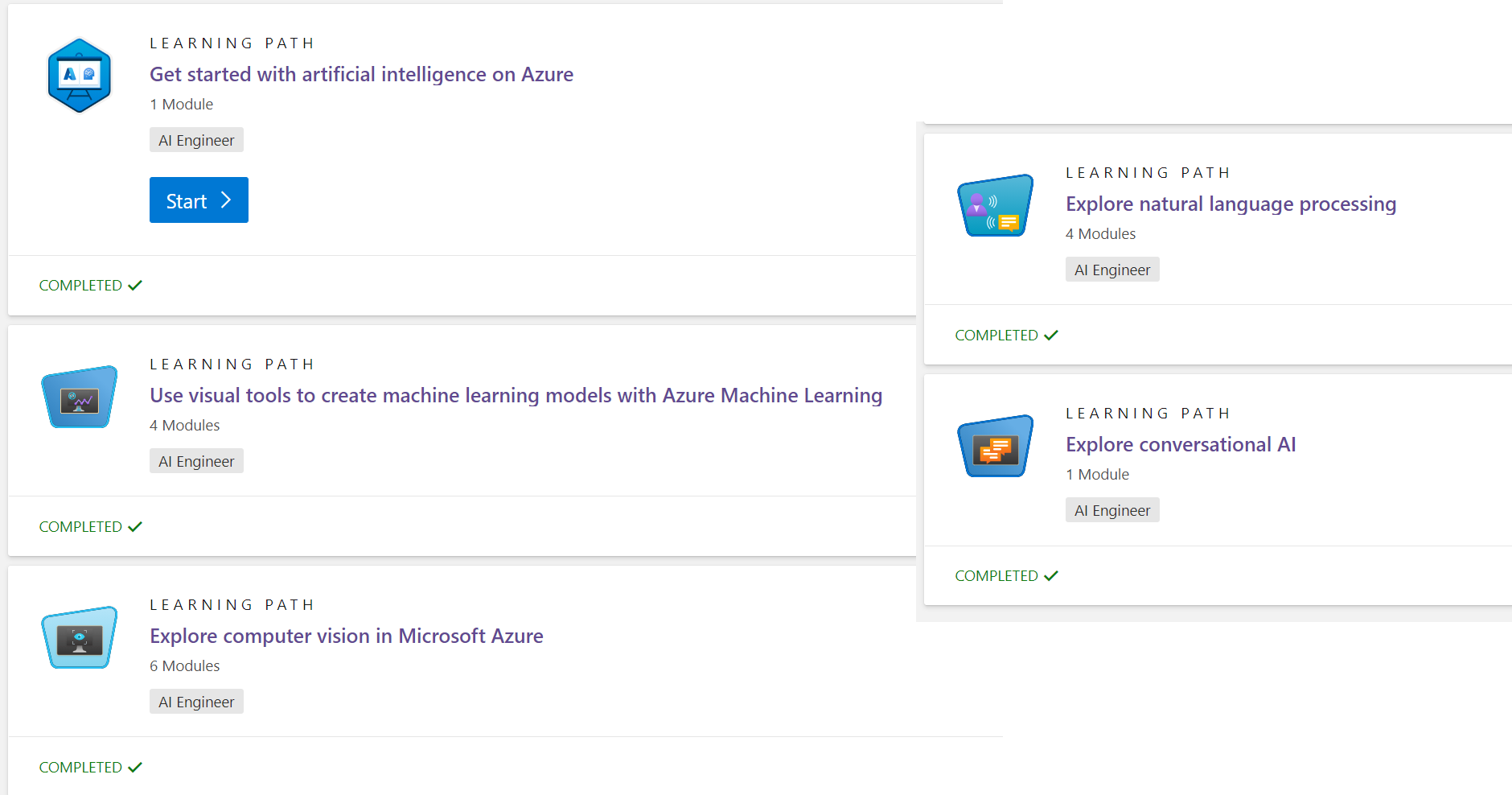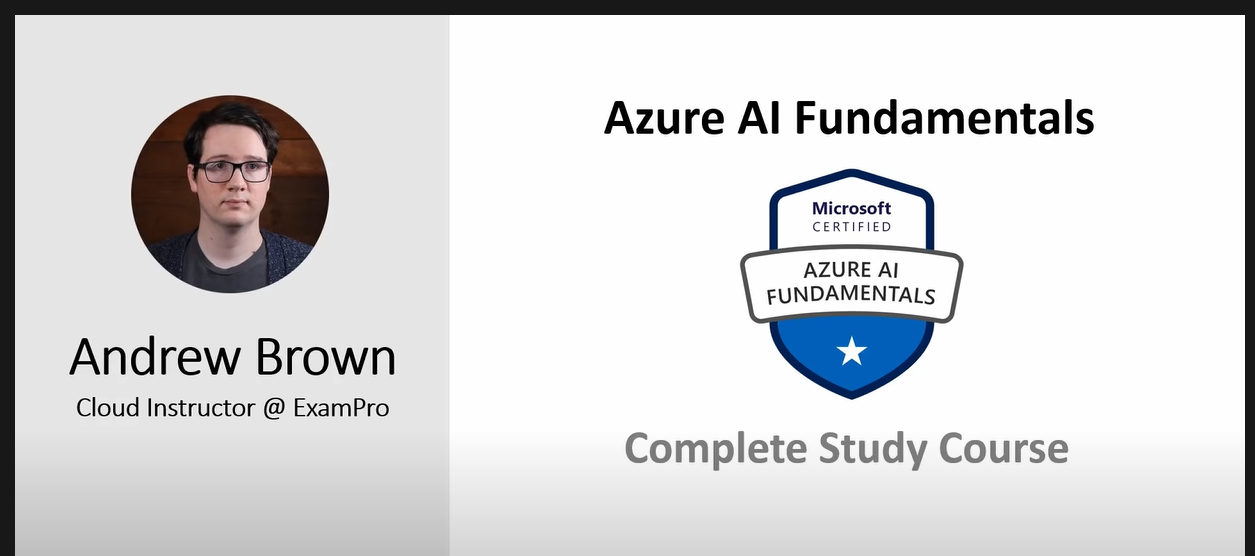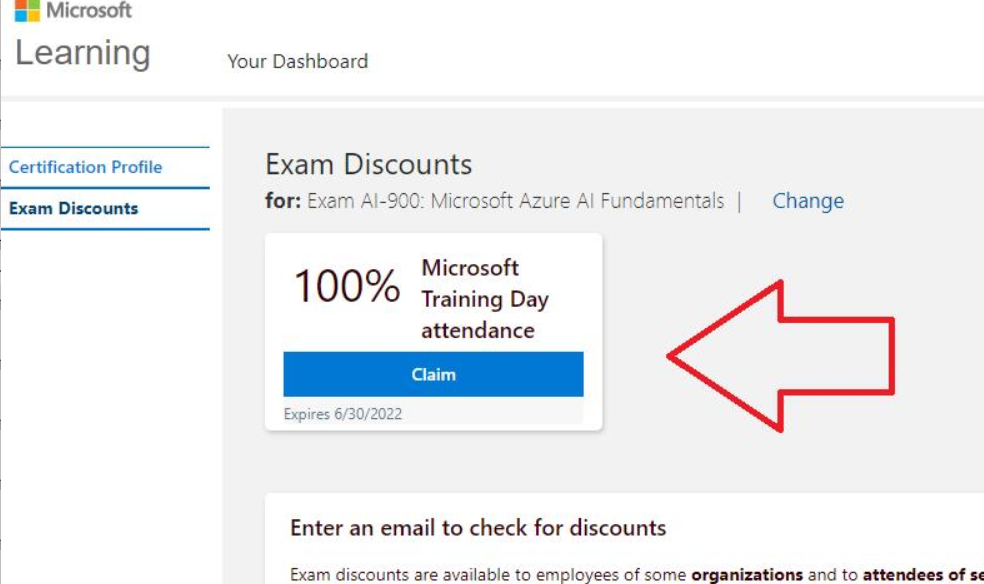AI-900 Microsoft Azure AI Fundamentals Certificate - Study Resources
I recently passed the AI-900 Microsoft Azure AI Fundamentals. I don’t have any prior experience with Artificial intelligence (AI) or Machine Learning before taking the exam. So I am sharing my experience with this certificate. If you are new to AI, don’t worry. I hope the following resources will help you.
Microsoft provides free virtual training for this certificate. I recommend you to start from this. Because you will get a free credit that you can use to take the Microsoft Azure AI Fundamentals certification exam at no cost. It would normally cost you $90 (USD).
Exam AI-900: Microsoft Azure AI Fundamentals is the link for the certificate. You can read about the skills measured in that link.
The registration link for the free virtual training is here “Microsoft Azure Virtual Training Day: AI Fundamentals”
Study Resources
1. Microsoft Certified: Azure AI Fundamentals - Online - Free
I studied all 5 paths from this link Microsoft Certified: Azure AI Fundamentals

I did most of the labs but it’s hard to do some labs so I just read/watched them.
I’ll share my notes at the end of this post but I highly recommend you to take your own note while you are studying. You should read it an hour before going for the exam. E.g. classification vs regression,Speech recognition vs synthesis. I got confused during the exam.
2. Microsoft Certified: Azure AI Fundamentals - Online - Free
I also watched Andrew Brown’s Azure AI Fundamentals Certification (AI-900) - Full Course to PASS the Exam

3. Other resources
I studied only two links above. but if you have more times to study, you could look at the links below.
- https://www.linkedin.com/learning/exam-tips-microsoft-azure-ai-fundamentals-ai-900/cognitive-services?u=89248082
- Practice Tests
- Tips: https://vritika.medium.com/microsoft-azure-ai-fundamentals-ai-900-how-to-prepare-and-pass-the-exam-279f66a74a8c
How to claim the exam discounts after the Azure virtual training.
You can go to Microsoft Certification Dashboard. You will see the Exam Discounts. For me, it should right away as long as I started the virtual training. Sometimes, you need to wait for 4 days. (If that page doesn’t load anymore, try it in the private mode. I think there are some issues with auth-cookies but I don’t think Microsoft is going to fix it soon.It has been like that for long time.) You can click on Claim and then schedule an exam.

My notes
Here is the list of notes that I took during my study. But I guess it will probably mean nothing to do unless you did the resource 1 and resource 2. So you can probably ignore them or make the notes on your own.
Layers of Machine Learning
- AI
- ML
- DL (Deep learning) - artificial neural network
Key elements of AI
- ML (prediction)
- Anomaly detection (credit fraud detecting)
- Computer vision (self-driving car)
- NLP (Natural language processing) - understand the language
- Conversational AI (bot)
Dataset - logical grouping of units of data
- MNIST db - handwritten digits
- COCO - Common Object in Context (JSON, images)
Labeling
- identifying raw data
- Supervised ML - labeling is a prerequisite to produce training data. label by human generally
- Unsupervised ML - labels will be produced by the machine
- ground truth (a properly labeled data that u use as the standard to train and assess a given model)
Supervised Learning
- Data has been labeled
- Task-driven
- Make a prediction (Classification, Regression)
Unsupervised learning
- Data has not been labeled
- data-driven
- Recognize a structure/pattern (Clustering, Dimensionality Reduction, Association)
Reinforcement Learning
- no data.
- There is an env and a ML model generates data - Game AI, learning task, Robot navigation
Classification
- Predict category to apply the input
- E.g. Will it rain next Sat?
- Binary classification - true or false
- Multiclass classification - label range like sad, happy, angry
Regression
- Predict this variable in future (what is the temp next week?)
- distance of vector from the regression line is called an Error
- MSE, RMSE, MAE
Clustering
- grouping unlabeled data
Confusion Matrix (error matrix )
- table to visualize the model prediction vs ground truth
Custom Vision
- A dedicated resource for the custom vision service, which can be either a training, a prediction or a both resource.
- Creating a Custom Vision resource for both training and prediction results in two separate resources being provisioned, each with their own key and endpoint.
Cognitive Services A general cognitive services resource that includes Custom Vision along with many other cognitive services. You can use this type of resource for training, prediction, or both.
- Precision: What percentage of class predictions did the model correctly identify? For example, if the model predicted that 10 images are oranges, of which eight were actually oranges, then the precision is 0.8 (80%).
- Recall: What percentage of the class predictions made by the model were correct? For example, if there are 10 images of apples, and the model found 7 of them, then the recall is 0.7 (70%).
- Mean Average Precision (mAP): An overall metric that takes into account both precision and recall across all classes).
- A cognitive services resource can be used for both training and prediction.
- support both Computer Vision for text extraction, and Text Analytics for text analysis.
- AI-infused
- Ample language
- low cost, including free tiers
Knowledge Mining
- use a combination of intelligent services to learn from vast amounts of info.
- Ingest
- Enrich
- Explore
Computer Vision
- only supports image analysis. A separate resource (with its own key and endpoint) would be required for text analytics.
- is when we use ML Neural Network to gain high-level understanding from image/video
- Algorithms - CNN, RNN
- Types, Image Classification, Object detection, Semantic Segmentation, Image Analysis, OCR, Facial Detection
- Seeing AI - iOS app
Custom Vision
- A dedicated resource for the custom vision service, which can be either a training, a prediction or a both resource.
- Creating a Custom Vision resource for both training and prediction results in two separate resources being provisioned, each with their own key and endpoint.
Azure AI
- Azure Experiments - is a logical grouping Azure run
- Azure Pipeline - executable workflow - subtask (steps) can run diff compute.
- Inference pipeline - real-time / batch
- Azure ML
- Jupyter
- Pythan
- MLOps
- ML Designer
- Data Labeling Service
- Responsible ML
Object detection
- is a form of machine learning based computer vision in which a model is trained to recognize individual types of object in an image, and to identify their location in the image
- A class label, probability, and bounding box for each object in the image
Face analysis
- is an area of artificial intelligence (AI) in which we use algorithms to locate and analyze human faces in images or video content.
- Computer Vision, which offers face detection and some basic face analysis, such as determining age.
- Video Indexer, which you can use to detect and identify faces in a video.
- Face, which offers pre-built algorithms that can detect, recognize, and analyze faces.
- Location of Face: A set of coordinates for each face, defining a rectangular bounding box around the face
- Extreme angles may impair facial detection
Read text with Computer Vision
- You need computer vision capabilities to “read” the text, and then you need natural language processing capabilities to make sense of it.
- is machine reading comprehension (MRC), in which an AI system not only reads the text characters, but can use a semantic model to interpret what the text is about.
Form Recognizer
- provides intelligent form processing capabilities that you can use to automate the processing of data in documents such as forms, invoices, and receipts.
- It comes with OCR (matching the filed name to value, processing tables of data, identifying the type of fields like date)
- comes with pre-build receipt model that knows sales receipts but the max file size is 50 MB.
- u can build the custom models
NLP (Natural Language Processing)
- understand the context
- e.g. Cortana
Neural Network
- describe as mimicking the brain (neuron/node represents an algorithm)
- the connection between neurons is weighted.
- the network is organized in layers (input layer, 1 to many hidden layer, output layer)
Deep learning
- neural network that has 3 or more hidden layers
- FNN (Feed forward Neural Network ) - always move forward between nodes
- BP (Backpropagation) - moves backwards and adjust the weight to improve the outcome. (This is how neural net learns. **)
- Loss Function - BP use loss function to compare the ground truth to the predication to determine the error rates
- Activation Function -
- Dense
- Sparse
Text Analytics
- can submit multiple docs
- detect the language name, ISO 6391, confidence score
- detection service will focus on the predominant language in the text (e.g. English and French. If more English then en is the predominant )
- (Sentiment analysis)evaluate text and return sentiment scores and labels for each sentence. (Positive = closer to 1), 0.5 is indeterminate, NaN when the lang is ambiguous.
- Key phrase extraction is the concept of evaluating the text of a document, or documents, and then identifying the main talking points of the document(s).
- Entity recognition - the Text Analytics service with unstructured text and it will return a list of entities in the text that it recognizes. e.g. Person => John, Location => Melbourne
Speech
- Speech recognition - the ability to detect and interpret spoken input.
- Speech synthesis - the ability to generate spoken output.
Speech recognition
- speech to text
- taking the spoken word and converting it into data
- use two models 1) acoustic - converts the audio to phonemes, 2) language - phonemes to works using a statistical algorithm that predicts the most of probable sequence of words
Speech synthesis
- text to speech
- tokenizes the text to break it down into individual words, and assigns phonetic sounds to each word.
- breaks the phonetic transcription into prosodic units (such as phrases, clauses, or sentences) to create phonemes that will be converted to audio format
- phonemes are then synthesized as audio by applying a voice, which will determine parameters such as pitch and timbre; and generating an audio wave form
Translate text and speech
- literal translations - old fashion - word to word translation
- Text translation - can understand the sematic context
- Translator Text Service
- text to text translation
- supports 60+
- ISO 639-1 language codes (e.g en) + appropriate 3166-1 cultural code (e.g en-US)
- Profanity (dirty words) filtering - filter out the dirty words
- Selective translation - tag the content so no need to localized.
- text to text translation
- Speech Service
- speech to text, text to speech, speech translation
- can translate multiple languages by using two “to”
Language Understanding Intelligent Service (Language Understanding)
- Utterances - example of something a user might say, and which your application must interpret. e.g. Turn on the light
- Entities - entity is an item to which an utterance refers. For example, fan and light
- Intents - goal
Tip: In a Language Understanding application, the None intent is created but left empty on purpose. The None intent is a required intent and can’t be deleted or renamed. Fill it with utterances that are outside of your domain
Language Understanding Service: A dedicated resource for Language Understanding, which can be either an authoring or a prediction resource.
Authoring
- you can use it to author and train a Language Understanding application by defining the entities and intents that your application will predict as well as utterances for each intent that can be used to train the predictive model.
- comes with pre-built
Entities
- 4 types
- Machine-Learned - are learned by your model from sample utterances)
- List - hierarchy of lists and sublist
- Regex
- Pattern.any
Train the model
Prediction The intent encapsulates the task (getting the time) and the entity specifies the item to which the intent is applied (the city).
Forecasting - make the prediction with relevant data Predication - Predict without relevant
Performance/Evaluation Metrics - the evaluate the diff algorithms
- Classification Metrics (accuracy, precision, recall, F1-score, ROC, AUC)
- Regression (MSE, RMSE MAE)
- Ranking (MRR, DCG)
- Statistical (Correlation)
- Computer Vision Metrics (PSNR)
- NLP (Preplexity, BLEU)
- Deep Learning Related (Inception, Frechet Inception)
Two type of evaluation metrics
- Internal -Metrics used to evaluate the internals of ML models (accuracy, F1, Precision, Recall)
- External - used to evaluate the final prediction
QnA Maker and Azure Bot Service
- QnA Maker. This cognitive service enables you to create and publish a knowledge base with built-in natural language processing capabilities.
- import the data
- publish
- access using knowledge base id, endpoint and auth key
- Azure Bot Service. This service provides a framework for developing, publishing, and managing bots on Azure
Responsible AI
- Fairness (Fairlearn - like hiring system without using gender)
- Reliability and Safety - If AI makes mistake, release a report quantified risks and harms to end-users
- Privacy and Security - PII (Personally Identifiable Information)
- Inclusiveness - should empower everyone and engage people
- Transparency - AI systems should be understandable
- Accountability - should work within framework of governance
More: https://www.microsoft.com/en-us/ai/responsible-ai?activetab=pivot1%3aprimaryr6
That’s all for now. As I mentioned, I am pretty new to this area. So, if you see something that I should update, feel free to let me know. Please share if you have more tips after passing the exam.
Good luck!
